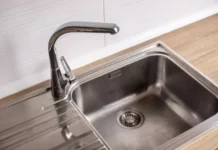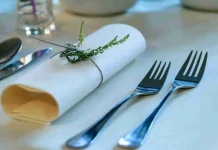When you hear the word “hard-anodized” cookware, it refers to aluminum cookware that has been hard-anodized. Aluminium in hard-anodized cookware is treated in a way that makes it more durable and durable. An electrical current is used to melt aluminum by soaking it in a chemical bath and exposing it to a strong current.
This process creates oxide, the rust-causing chemical. The oxide hardens on the aluminum’s surface, making it significantly more durable and resistant to corrosion in the future.
While hard-anodized cookware is sometimes regarded as a separate category from non-stick cookware, almost all hard-anodized innovations also have a non-stick surface. When hard-anodized cookware was first developed decades ago, it did not contain a non-stick coating. Late in the 1990s when non-stick cookware got famous, hard anodized cookware makers began coating it. When you see hard-anodized cookware, know that the base is hard-anodized aluminum, while the surface is covered with a non-stick substance.
Let’s discuss the pros and cons of hard anodized cookware.
Pros of Hard Anodized Cookware
Let’s start with the good stuff. Here in this section, we will discuss the benefits of hard-anodized aluminum cookware, along with a concise explanation of each.
Durability
How often have you had to replace or repair cookware that was warped or scratched? A coating of oxide generated during the anodizing process protects hard-anodized aluminum. This strengthening procedure not only makes the cookware corrosion-resistant but also makes it less vulnerable to warping.
Hard-anodized aluminum is so strong, that it is significantly less likely to be damaged.
Hard-anodized cookware won’t rust, which may happen with regular metal that hasn’t been anodized.
Scratch-Resistant
In addition to the cookware’s general durability, hard-anodized aluminum also protects the surface from wear and tear from kitchen instruments like spatulas and forks.
Scratches and dents are typical complaints about consumer cookware, and finding these flaws after only a few uses is doubly aggravating if you’ve paid a premium.
This irritating condition may be avoided by using hard-anodized cookware, which is more likely to maintain a smooth, uniform surface over time.
Stackable
Hard-anodized cookware is simple to store because of its scratch resistance. Your anodized cookware may be stacked or nestled without causing harm. In fact, certain alternatives, like Calphalon Premier, are built expressly for stacking. This stackability is perfect if you have limited room, such as if you live in a tiny apartment or an older home with a galley-style kitchen.
It’s particularly useful during a move, as it relieves some of the stress that comes with packing your pricey kitchen appliances.
Doesn’t Leach Metals
Many people are concerned that as the nonstick coating on aluminum cookware wears off, metal will leak into their food. While this is a legitimate issue with non-anodized cookware, the anodizing process, whether with or without a non-stick coating, naturally protects the metal from corroding. As a result, hard-anodized cookware is safe to use, and the metal won’t contaminate your food.
This technique also renders the cookware non-reactive, which means acidic elements like lemon juice or vinegar won’t harm it or cause the aluminum to react, creating a metallic flavor.
Heat-Conductive
Cookware made of anodized aluminum is known for its excellent thermal conductivity. A feature that many other cookware options lack.
When cooking delicate foods like flaky fish, this means you’ll obtain a more even and tender result. You won’t have to wait as long for the water to boil, and there will be no soggy pancakes or overdone eggs.
Due to aluminum’s thermal conductivity, hard-anodized cookware is also extremely sensitive, which means it heats and cools rapidly when the stove temperature changes. This comes particularly handy when creating one-pot dishes that need regular heat adjustment.
Versatile
Hard-anodized aluminum is superb all-purpose cookware because of the non-stick coating. It may be used to cook a wide range of dishes, including delicate components like fish or eggs.
The cookware is extremely easy to clean thanks to the coating. You’ll enjoy hard-anodized cookware if you’re weary of scrubbing stuck-on food till your hand’s wrinkle.
Enables Healthier Cooking
You won’t need to use much butter or oil in this pan because it’s non-stick. This is a huge benefit for those who want to lose weight or lower their cholesterol.
Low Maintenance
Another benefit of hard anodized cookware is that it does not need to be seasoned. Seasoning is a common requirement for various types of cookware, such as cast iron.
You may use hard-anodized cookware straight out of the box as long as you follow the required hygienic measures and wipe off your cookware after opening it.
The Cons of Hard Anodized Cookware
Without considering the drawbacks, no analysis would be complete. The downsides of hard anodized cookware are discussed in this section.
Appearance
Hard-anodized pots and pans, unlike ceramic and enameled cookware, have a restricted range of colors and luster. As a result of the anodizing process, they are usually dark or charcoal gray in color and have a dull feel.
You’ll have to seek elsewhere if you want to add a splash of color to your kitchen. With their exquisite sheen, stainless steel or copper can also be used as serving plates. Hard-anodized aluminum pans, on the other hand, should be kept in the kitchen and not on the dining room table.
Exterior Stains
One of the most common concerns about hard-anodized aluminum is that it stains easily. When cooking, ingredients that run over the sides may stain the exterior over time. These stains are tough to remove since they burn into the metal, but it’s not impossible.
Expensive
Though more expensive than stainless steel, hard-anodized cookware is still less costly than non-anodized aluminum. Depending on the brand and collection, the price range might be rather wide.
Heavy
Hard-anodized aluminum is somewhat heavier than ordinary aluminum, with a weight difference of around two milligrams per square centimeter. It’s usually thicker than aluminum cookware and certain stainless steel cookware.
This might make the cookware seem “bulkier” than regular aluminum cookware, making it more difficult to use and move in tiny kitchens.
Not Dishwasher-Safe
Due to its non-stick coating, hard-anodized aluminum cookware should only be hand washed. The dishwasher’s high temperature, strong chemicals, and sharp tools may cause the nonstick coating to deteriorate.
Never use abrasive sponges or strong chemicals when hand-washing this type of cookware.
Quality Varies Across Brands
There are a number of hard-anodized cookware manufacturers, and they are not all equally good.
Several factors affect the quality of cooking, including shape, thickness, and the quantity of non-stick coatings. Make sure you choose cookware that is heavy-gauge, the thickest type, to ensure a more even heating process.
Calphalon’s Premier and Signature ranges include heavy-gauge cookware. This cookware has 3.6mm thick walls, which is around 20% thicker than medium-gauge cookware.
Short Lifespan
Another disadvantage of hard-anodized cookware is that the non-stick coating will wear away over time. The coating will endure between two and five years under typical conditions. You’ll need to replace your cookware if this happens.
There are several things you can do to extend the life of the nonstick coating, but it will not last indefinitely.
Incompatible With Induction
Induction stovetops are common in contemporary kitchens. Unfortunately, induction is not compatible with hard-anodized metal. Therefore, hard-anodized aluminum isn’t a good choice if you own or intend to buy an induction cooktop.
Hard-anodized pans with a metal disc added to the bottom particularly to make them induction-friendly are the exceptions to this rule.
Bottom Line:
To summarize the Pros and Cons of Hard Anodized Cookware, hard-anodized cookware is adaptable, easy to maintain, extremely robust, and conducts heat better than many other alternatives.
It has a short lifespan (about two to five years), is incompatible with induction cooktops, and has a drab and uninspiring look.
If you’re determined to have a nonstick pan, choose hard-anodized aluminum. It’s significantly more robust and safer than normal aluminum, plus it’s easier to clean and heats evenly than nonstick cookware with a stainless steel base.














